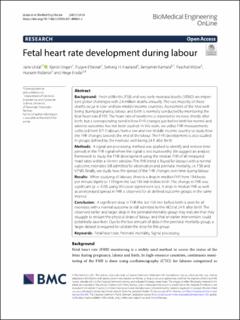| dc.contributor.author | Urdal, Jarle | |
| dc.contributor.author | Engan, Kjersti | |
| dc.contributor.author | Eftestøl, Trygve Christian | |
| dc.contributor.author | Haaland, Solveig H. | |
| dc.contributor.author | Kamala, Benjamin | |
| dc.contributor.author | Mdoe, Paschal Francis | |
| dc.contributor.author | Kidanto, Hussein | |
| dc.contributor.author | Ersdal, Hege | |
| dc.date.accessioned | 2021-11-02T14:24:38Z | |
| dc.date.available | 2021-11-02T14:24:38Z | |
| dc.date.created | 2021-08-31T23:44:51Z | |
| dc.date.issued | 2021-03 | |
| dc.identifier.citation | Urdal, J., Engan, K., Eftestøl, T. et al. (2021) Fetal heart rate development during labour. Biomedical engineering online, 20 (1), 1-20. | en_US |
| dc.identifier.issn | 1475-925X | |
| dc.identifier.uri | https://hdl.handle.net/11250/2827335 | |
| dc.description.abstract | Background
Fresh stillbirths (FSB) and very early neonatal deaths (VEND) are important global challenges with 2.6 million deaths annually. The vast majority of these deaths occur in low- and low-middle income countries. Assessment of the fetal well-being during pregnancy, labour, and birth is normally conducted by monitoring the fetal heart rate (FHR). The heart rate of newborns is reported to increase shortly after birth, but a corresponding trend in how FHR changes just before birth for normal and adverse outcomes has not been studied. In this work, we utilise FHR measurements collected from 3711 labours from a low and low-middle income country to study how the FHR changes towards the end of the labour. The FHR development is also studied in groups defined by the neonatal well-being 24 h after birth.
Methods
A signal pre-processing method was applied to identify and remove time periods in the FHR signal where the signal is less trustworthy. We suggest an analysis framework to study the FHR development using the median FHR of all measured heart rates within a 10-min window. The FHR trend is found for labours with a normal outcome, neonates still admitted for observation and perinatal mortality, i.e. FSB and VEND. Finally, we study how the spread of the FHR changes over time during labour.
Results
When studying all labours, there is a drop in median FHR from 134 beats per minute (bpm) to 119 bpm the last 150 min before birth. The change in FHR was significant (p<0.05) using Wilcoxon signed-rank test. A drop in median FHR as well as an increased spread in FHR is observed for all defined outcome groups in the same interval.
Conclusion
A significant drop in FHR the last 150 min before birth is seen for all neonates with a normal outcome or still admitted to the NCU at 24 h after birth. The observed earlier and larger drop in the perinatal mortality group may indicate that they struggle to endure the physical strain of labour, and that an earlier intervention could potentially save lives. Due to the low amount of data in the perinatal mortality group, a larger dataset is required to validate the drop for this group. | en_US |
| dc.language.iso | eng | en_US |
| dc.publisher | BioMed Central | en_US |
| dc.rights | Navngivelse 4.0 Internasjonal | * |
| dc.rights.uri | http://creativecommons.org/licenses/by/4.0/deed.no | * |
| dc.subject | obstetrikk | en_US |
| dc.subject | dødfødsel | en_US |
| dc.title | Fetal heart rate development during labour | en_US |
| dc.type | Journal article | en_US |
| dc.type | Peer reviewed | en_US |
| dc.description.version | publishedVersion | en_US |
| dc.rights.holder | © The Author(s) 2021 | en_US |
| dc.subject.nsi | VDP::Medical disciplines: 700::Clinical medical disciplines: 750::Gynecology and obstetrics: 756 | en_US |
| dc.source.pagenumber | 1-20 | en_US |
| dc.source.volume | 20 | en_US |
| dc.source.journal | Biomedical engineering online | en_US |
| dc.source.issue | 1 | en_US |
| dc.identifier.doi | 10.1186/s12938-021-00861-z | |
| dc.identifier.cristin | 1930272 | |
| cristin.ispublished | true | |
| cristin.fulltext | original | |
| cristin.qualitycode | 1 | |

